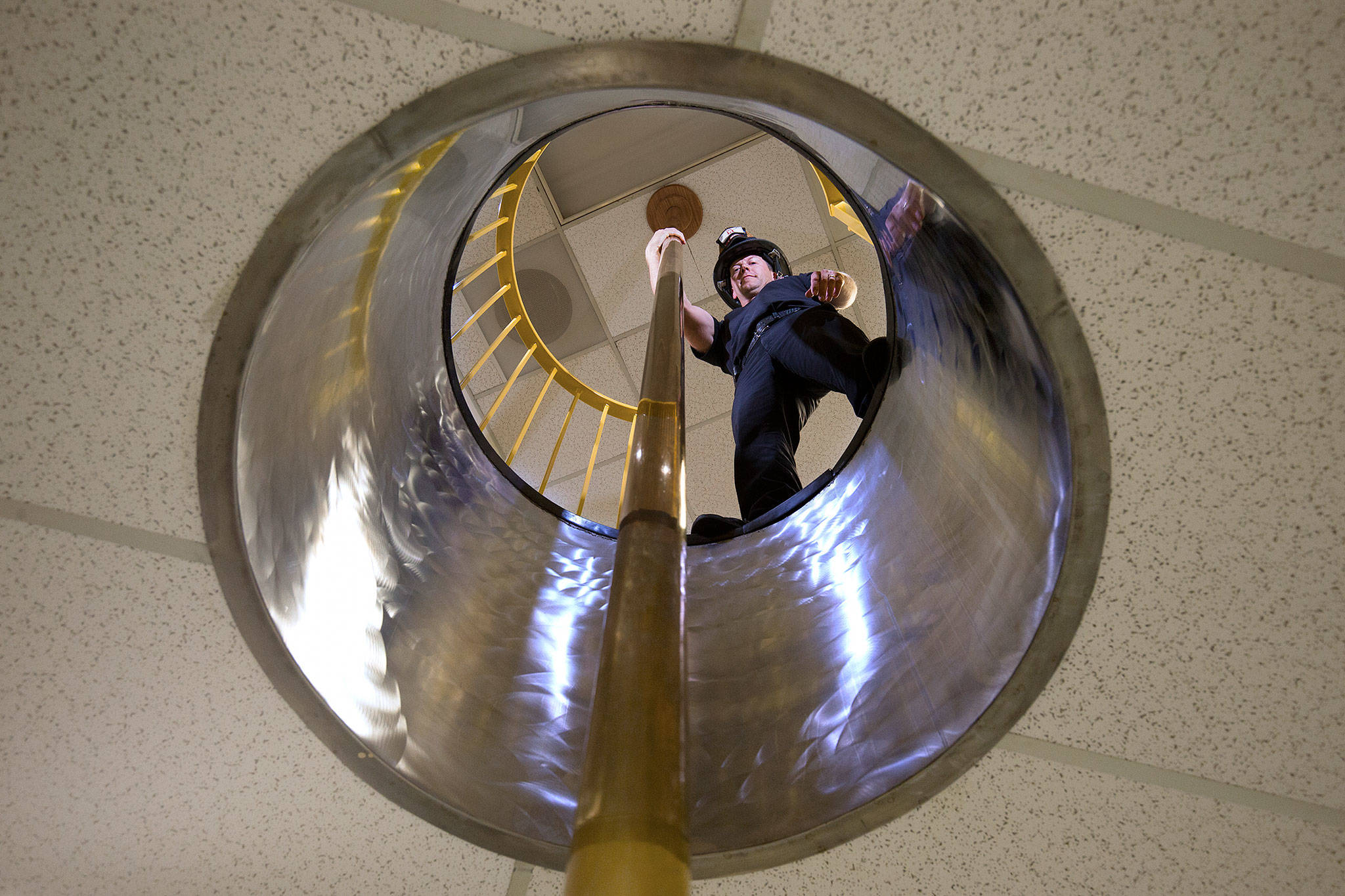EVERETT — It’s a symbol of firefighters, superheroes and dancers.
But the pole has all but vanished from most fire stations these days.
What’s up with that?
Taking the steps is safer.
The 20-foot sliding pole at Everett Fire Department Station 1 on Rucker Avenue is the last one standing in the city’s six firehouses. It might be the only functional fire pole in Snohomish County, based on responses from inquiries sent to local fire districts.
At one time, the fire pole was a speedy way to get from the bunks to the rigs. Now the gleaming brass pole usually gets eschewed for the stairs by the firefighters at Station 1.
“Waking up at 2 in the morning and you’re kind of wandering around to get your bearings then making sure you don’t break your ankle when you come down, it’s just easier to use the stairs,” said firefighter/paramedic Jack Murrin.
Or risk come down on someone’s head, if a bunch of people are using it in the middle of the night.
Mastering the pole is simple. Think Batman and Robin sliding down the pole in the Batcave.
Grasp your hands, clamp your legs, and down you go.
At pole dance studios as well as gentlemen’s clubs, there’s a fancier version of the move called the fireman’s spin. The pole at the Station 1 is (reportedly) not used for dancing.
“That might be frowned upon,” Murrin said. “And there might be pictures taken. We do not want pictures taken of something like that.”
The use of a pole has become an official sport for fitness and dance by both men and women, with athletic tournaments, such as the annual national pole competition in Seattle. The pole is a platform for working out, rather than rushing to a fire.
Historically, the fire pole went from sleeping quarters to the bay, where the rigs were parked. Firefighters would hop out of bed, zip down the pole, pull on boots and be ready to roll.
A pole was as iconic as a Dalmatian.
The dappled dogs are long gone. Also gone are the horses, which were used to pull the 19th century fire engines, and led to the poles in a roundabout way.
Back then, spiral staircases were common at fire stations because otherwise horses could try to climb stairs into the living quarters. You wouldn’t want your first responders to have to wrangle a horse out of their bedroom.
Thus, the pole was born.
According to internet lore, the first firehouse pole was installed in 1878 by Chicago fire Capt. David B. Kenyon, whose station’s top floor contained a contraption that moved hay to the lower floor using a wooden pole.
After a fireman slid down the pole to respond to a call, Kenyon was inspired to create a permanent pole. A 3-inch diameter pole was crafted from a Georgia pine beam, then coated with varnish and paraffin. His station was usually the first to arrive when called, especially at night, so the chief ordered the poles to be installed in all Chicago fire stations. In 1880 the first brass pole was placed in the Boston Fire Department.
The rest is history — until modern-day risk managers got in the game.
“The problem with the poles is that people got hurt,” said Snohomish County Fire District 5 Chief Merlin Halverson, whose Sultan station is poleless.
“I had friends who were in Spokane and they were showing off the pole to a bunch of kids and so they had one of the guys slide down the pole and he broke his leg in front of all the children. So they herded the children off to the fire trucks and the ambulance took him to the hospital.”
Halverson himself has never used a fire pole.
“I spent 32 years in the city of Lynnwood and we had a station all on one level and our fire trucks weren’t even red, they were yellow. So when kids came to visit they were disappointed,” Halverson said. “No poles. No red trucks. And no spotted dogs.”
The city of Seattle had to pay a former firefighter $12.75 million for debilitating injuries when he fell 15 feet through a fire pole hole in 2003.
Many stations now have guardrails around the poles. The one at Everett’s Station 1 is encircled by a bright yellow rail with a latched gate.
“Nothing I know has ever happened here as far as injuries,” Everett Assistant Fire Marshal Steve Goforth said.
The pole was brought over from former Station 2 when the Rucker Avenue firehouse opened in 1992.
“We kept one for posterity purposes,” Goforth said.
Other historical items displayed at the Rucker property include leather helmets, nozzles and the front panel of a 1967 yellow Mack fire truck.
The pole is a hit with tour groups.
“The kids who come through always want to slide down,” Goforth said.
The firefighters are happy to oblige, with care.
“We try to get them tired here before we take them out to the bay with the trucks. Get that energy out. Either that, or we take them out in back and let them shoot the hose a bit.”
Andrea Brown: abrown @heraldnet.com; 425-339-3443. Twitter @reporterbrown.
Talk to us
> Give us your news tips.
> Send us a letter to the editor.
> More Herald contact information.

























